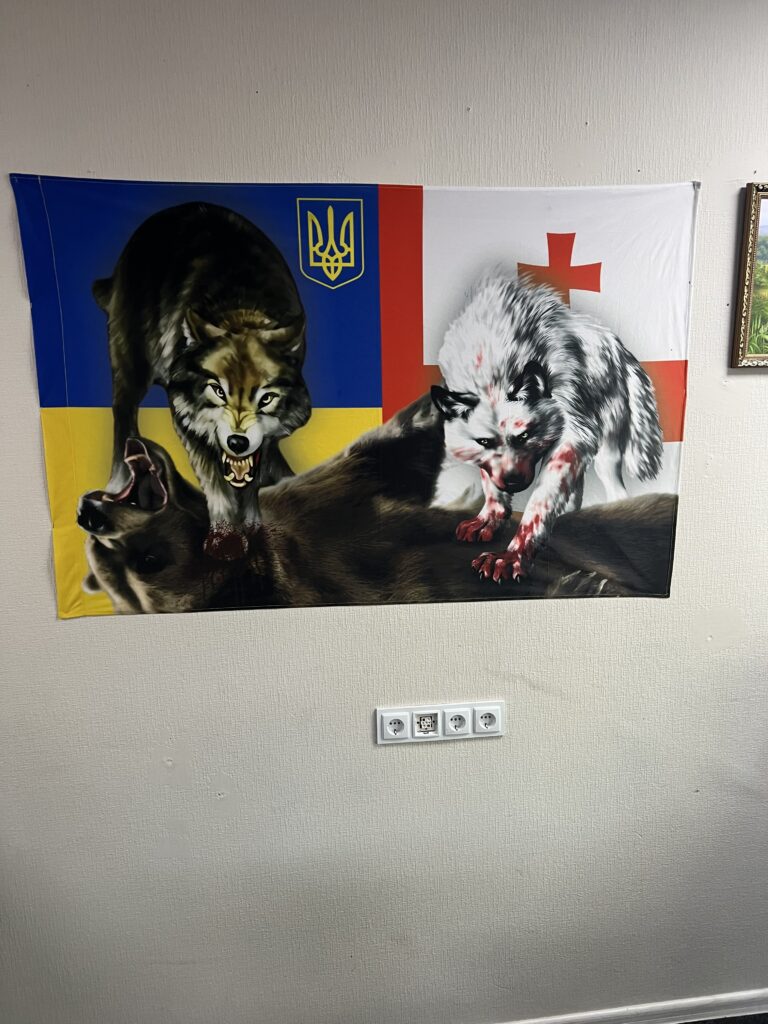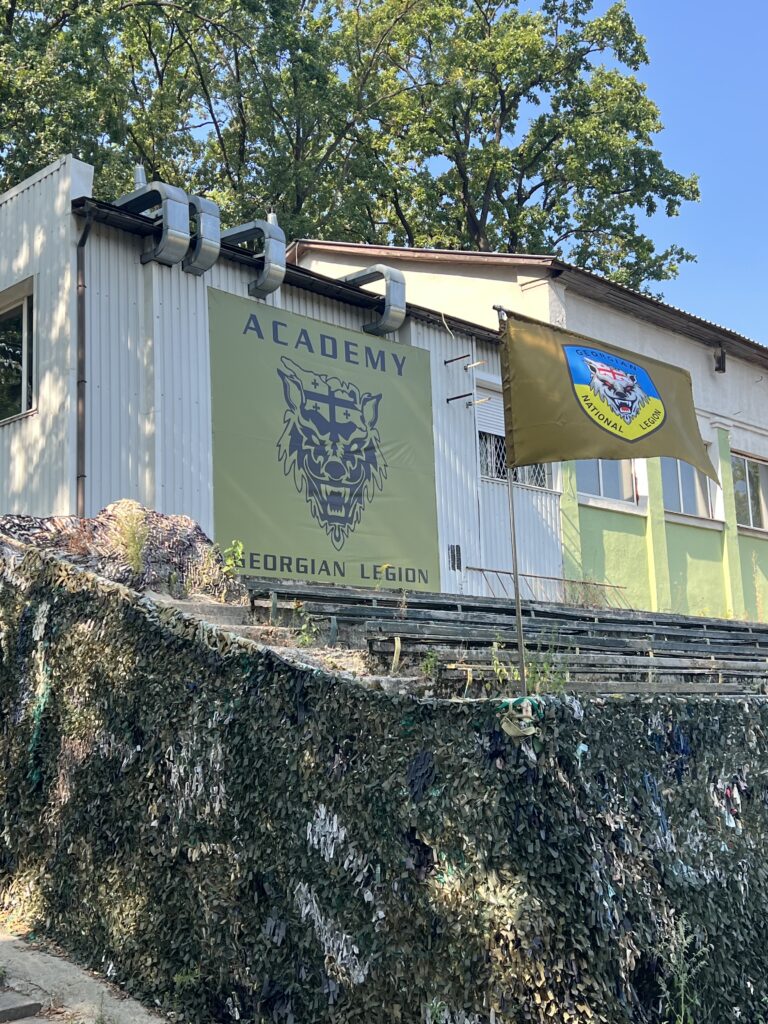Ukraine Diary 2: Georgian Legion, Higher Education, and the Ukrainian Left

Our first meeting Thursday morning was with Mamuka Mamulashvili, leader of the Georgian Legion. We met at the Legion’s base, a set of old buildings (near a school, where we could hear the children at recess), not far by car from downtown. The Georgian Legion is a 2300 strong unit featuring multinational fighters, with the vast bulk (75%) hailing from Georgia. It has been in operation in Ukraine since 2014, and many of its member have considerable experience fighting against the Russians. Only experienced soldiers are accepted; other volunteers are free to join the Ukrainian Armed Forces. Apparently the Legion even includes a small cohort of Japanese soldiers who serve some unspecified purpose, as well as a squad of Pan-American fighters from a variety of Spanish-speaking countries. The Legion fights on the front, but it also maintains this base as a training area for its own personnel and for Ukrainian Territorial Forces.

Mamuka argued that what Ukrainian forces really needed were ATACMS and mortar-launched cluster munitions. F-16s were pretty but not necessary and not particularly useful in the current context. ATACMS, however, would enable Ukraine to tear apart Russian command and control, hit key logistics points, and destroy the Kerch Bridge. Mamuka exhibited no interest whatsoever in coming to terms with the Russians; he believed that either Russia would lose (and probably crumble) or Ukraine would lose, in which case both Ukraine and Georgia would also be subjected to harsh Russian occupation. Perhaps most intriguing from my point of view, the Georgian Legion was trying out a militarized version of the two-wheel scooters that are so common on American college campuses, but that could go farther, carry more, and had heavy duty tires.

After lunch I had an extraordinary Zoom conversation with a dean from Kharkiv National University. This was not part of the tour specifically, but I had some time open and Ukraine on the mind so I decided to go ahead and make the call. He described the difficulties facing the university, some of which were peculiar to Kharkiv’s situation (near the front in the early days of the war) and some of which were applicable to Ukrainian higher education more generally. I’ll have a longer article about this later but here are my first impressions.
Unlike most universities in Ukraine, Kharkiv National University came under direct Russian shelling, causing significant damage to the physical plant. This put extraordinary pressure on the faculty and student populations. Many faculty at the university had gone and were extremely unlikely to come back. Some of these joined the war effort, some were killed or injured in the bombing, and some sought opportunities internationally or elsewhere in Ukraine. Male faculty members of military age could not leave the country, although they were exempt from conscription, but many had joined the fighting anyway or had moved to positions farther from the front.
With respect to students, Kharkiv National University had an enrollment of 16000 prior to Russia’s invasion, 4000 of whom were international, the latter drawn primarily from India and a variety of African countries. Those 4000 students left, in generally unpleasant circumstances, in the first days of the conflict. Few expect them to return, in part because of the circumstances of their exit, and in part because other countries (including Russia) have taken advantage of Ukraine’s situation to poach new and existing students. Ukrainian universities are funded more generously by the state than American universities, but like American institutions they have come to depend on tuition dollars from international students, and so the long-term loss of a substantial proportion of those students promises to hit hard.
The Dean also spoke about the research situation. Especially in the physical sciences, the damage to university facilities and the loss of reliable electricity have been devastating. Modern scientific research requires sophisticated equipment and the support of graduate and undergraduate research assistants. Those assistants are gone, the equipment has been damaged by war, and the power supply necessary to maintain experiments has become inconsistent. Worse, the diversion of heating to civilian use during the winter (absolutely necessary for the war effort) has meant that much equipment suffered damage from severe cold temperatures. Campuses across the country suffer from these issues to lesser or greater effect, meaning that academic research has ground to a halt in the hard sciences.
The Dean concluded with an argument that will warm the hearts of advocates of higher education. Ukraine’s technological and economic future, he argued, depends to great extent on the health of its universities. If the university system cannot produce scientists and engineers, then Ukraine will struggle to rebuild itself and to achieve economic competitiveness. It may not be able to take advantage being brought into the Western technology family, one of the most critical aspects of EU membership. He followed this up by arguing that it was also crucial that engineers and scientists receive an education in what it meant to be Ukrainian; in order to have a connection with the country, they should be familiar with its history, its literature, its culture, and its language. It was not enough for the West simply to send engineers to assist in reconstruction who have no connection with the country. This was one of the most aggressive defense of the liberal arts that I have ever heard from a professor in the “hard” sciences.
Thursday evening we met a young Ukrainian socialist named Vlad. He met us near Baba Yar, shortly after our first experience of Kyiv’s mass transit system. It may not surprise many folks here to learn that the metro train system in Kyiv is competitive with both New York and DC, although that says more about the absolute atrocity of American mass transit than it does about what a good job the Ukrainians have done with limited resources. In any case, the stations are very deep, and both the escalators and the trains are extremely fast. Our visit to Baba Yar was cut short by an unexpected (and very heavy) rainstorm that left us running through the trees for shelter.

The conversation with Vlad was too much to summarize easily. Too many on the Left, I think, are offended that Ukrainians are fighting for a set of values that they consider milquetoast, even middlebrow. Too many on the Right think that Ukraine is fighting for the wrong values altogether. Vlad made clear that notwithstanding his skepticism of aspects of the Ukrainian state, he and his friends absolutely could not abide the idea of occupation by Russia. Security, it seems, comes before all other political needs. Among other things we discussed the state of the US defense industrial base; why, Vlad wondered, did it take so long for the United States to ramp up production on equipment that it had previously promised to deliver. I explained as best I could that there were industrial, administrative, and political bottlenecks, an answer that satisfied neither of us. We ended the day with a long walk through central Ukraine, including a visit to the Saint Sophia cathedral. The square outside the cathedral is now home to a collection of broken Russian tanks, artillery pieces, and infantry fighting vehicles.
And then I went to bed. If you’d like to listen to Matt discuss his perspective on the trip, he spoke with Sam Seder about it a couple days ago.


